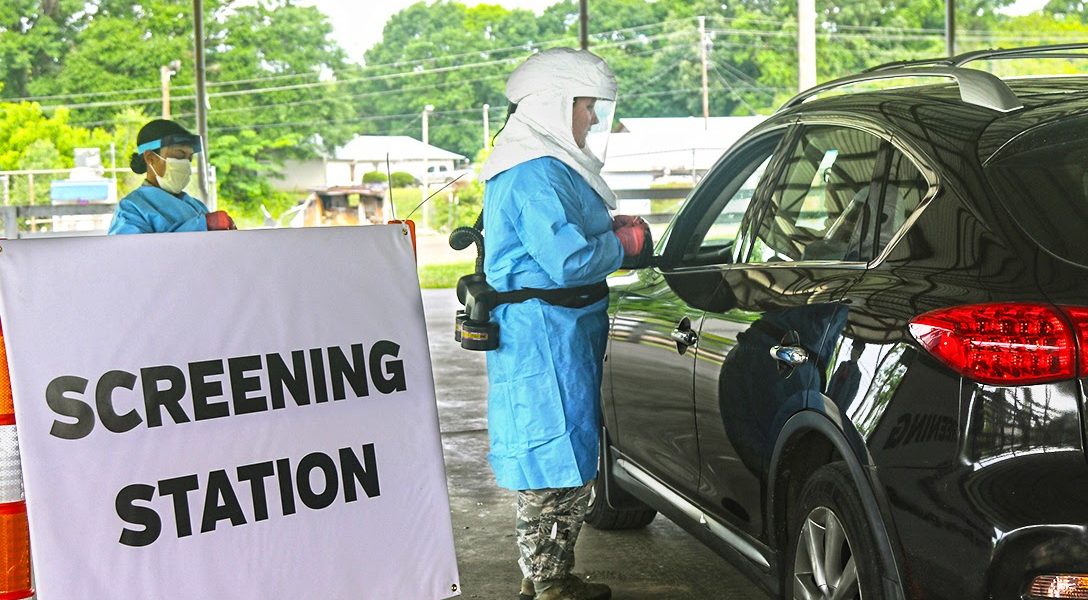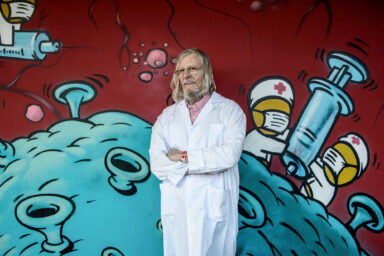A Harvard epidemiologist proposes a coronavirus test that is fast, inexpensive, and could be effective in stopping the pandemic. The only obstacle is getting the FDA to notice.
Laurence Kotlikoff wants you to know that we already possess technology that could change the course of the coronavirus pandemic.
He wants Donald Trump to know, and Joe Biden to know, and Mitch McConnell and Nancy Pelosi and Chuck Schumer to know. Perhaps most importantly, he wants Stephen Hahn, commissioner of the Food and Drug Administration, to know that scientists have already invented the “atomic bomb” that could help us win the war against SARS-CoV-2: an inexpensive, widely available, at-home test.
These politicians, however, do not seem to be listening to Kotlikoff and his colleagues, and — more than a month after publishing a letter in the New York Times with epidemiologist Michael Mina which lays out their approach to ending the pandemic — Kotlikoff is losing patience.
“If the head of the FDA is not aware of this problem,” Kotlikoff, a professor of economics at Boston University, told WhoWhatWhy, “he should be fired. And if he is aware of this problem and has not fixed the problem, he should be fired. The FDA is engaged in deadly regulation that is killing [Americans]. This is stupidity beyond belief, and it is holding up what could be a way to capture [and] contain … the virus almost overnight.
“This is a case of the perfect but impossible not just being the enemy of the good — but the destroyer of the good.”
Kotlikoff and his colleague Michael Mina, an assistant professor in immunology and infectious disease at the Harvard T.H. Chan School of Public Health, have proposed a strikingly simple solution to what has been, for most of 2020, an intractable problem.
Testing for the coronavirus in the US has been troubled since the beginning of the pandemic. Are the tests accurate? Are we conducting enough tests? Are we testing the right people? Do we have enough materials to produce tests? Are we using the correct kind of test? Do people receive their results quickly enough to make informed decisions about quarantine and treatment? At various points in the six months since the pandemic reached America, the answer to all of these questions has been “No.”
“We have created this whole ecosystem in which we are so focused on high-end, expensive tests that we are [effectively] not testing anyone because we are trying to use clinical grade tests. If you look at the CDC’s latest estimate, 9 out of 10 people go undiagnosed with this virus today in the US.”
The US already possesses both the scientific technology and the facilities to produce a different kind of test for the virus. These tests — antibody-coated strips of paper to which individuals would apply their own saliva — could be produced for around $1 to $5 each. They could be used daily, or even multiple times a day, to detect active infection and transmission of SARS-CoV-2 and to help individuals determine when they need to isolate to prevent spreading the coronavirus.
“This is an answer,” Kotlikoff said. “This is the answer.”
These tests could be produced in large quantities almost immediately because they could be made and distributed, according to Mina, by almost any facility that makes paper. They already exist in prototype. Manufacturers are not producing them, however, because, under current guidelines, they are not likely to be approved for diagnostic use by the FDA.
As Mina explained when he appeared as a guest on the podcast This Week in Virology, “We have created this whole ecosystem in which we are so focused on high-end, expensive tests that we are [effectively] not testing anyone because we are trying to use clinical grade tests. If you look at the CDC’s latest estimate, 9 out of 10 people go undiagnosed with this virus today in the US.”
The current test used to detect coronavirus infection is the polymerase chain reaction (PCR) test, an extremely sensitive test that detects minute amounts of viral material in upper or lower respiratory specimens. According to Mina, there are myriad problems with this test as it is being utilized in the US. It is expensive. It is time-consuming. Perhaps most importantly, the test is so sensitive that it can detect even fragments of viral RNA, thereby diagnosing as “positive” individuals who are no longer actively transmitting the virus.
In fact, according to Mina, “the vast majority of PCR positive tests we currently collect in this country are actually finding people long after they have ceased to be infectious.”
Late or overdiagnosis has serious consequences. In Massachusetts, for example, Mina explained on This Week in Virology, “the suggestion for contact tracing is to take people from the point that they were positive-sampled and ask them to think back two days; so we are essentially taking people who might be two weeks post-transmissability, and we are spending huge dollars to go and contact-trace people they were with over the last two days — it’s completely ridiculous.”
A huge — perhaps incalculable — amount of money has been spent and will be spent on this high-sensitivity testing. Based on the number of total tests conducted in the US (nearly 65.8 million as of August 11, at an average cost of $100), it seems likely that the US has already spent more than $6 billion on testing alone.
It is also unquestionably true that some facilities are profiting exorbitantly from serology and PCR coronavirus testing. ProPublica has reported on one clinic in Texas which charged $2,479, including a $1,784 “facility fee,” for administering a $175 COVID-19 antibody test to a child who did not even leave his parent’s car while being tested.
An inexpensive paper test would be, of necessity, less sensitive than the sort of test conducted within a lab, but Mina says that is beside the point.
“Imagine you are a fire department and you want to make sure that you catch all the fires that are burning so you can put them out. You don’t want a test that’s going to detect every time somebody lights a match in their house — that would be crazy: you’d be driving everywhere and having absolutely no effect. You want a test that can detect every time somebody is walking the streets with a flame-thrower.”
Patients with a high viral load in their respiratory secretions — some of whom may not yet even be symptomatic — are the ones “walking the streets with a flame-thrower.” Samples collected from these patients contain, according to Mina, millions, billions, or even trillions of copies of the virus per milliliter, a concentration easily detected by paper tests. These “floridly positive” patients are the ones who must isolate themselves to halt the spread of the virus.
Extremely sensitive tests are not only more expensive and difficult to produce, but they may be counterproductive insofar as they fail to distinguish between individuals who are transmitting virus and those who are recovering from infection but no longer contagious. Furthermore, due to the difficulty of accessing testing and the backlog in processing, Kotlikoff estimates that less than 3 percent of actively infected people are being diagnosed by PCR tests in time to take steps to avoid infecting others.
“The PCR test,” Kotlikoff explained, “is generating false positives all the time. [It] is not a perfect test, but somehow is being held up as the gold standard; well, it’s the gold standard that nobody is using and it’s totally ineffectual and it’s too expensive and it’s too slow — it’s a worthless test at this point. So we’re holding up something that is worthwhile and could save the day to meet the standard of something that is worthless.”
As long as the FDA applies the same high sensitivity standards to rapid paper tests as they do to diagnostic tests conducted in labs, manufacturers will not produce the test due to “regulatory risk;” under current guidelines, to do so would be illegal. The paper tests could theoretically be recategorized as “surveillance” tests that would be held to a lower standard of sensitivity, but there is, in fact, as Jonathan Shaw recently reported, “no alternative regulatory process for tests designed to ensure population-level wellness — such as a certification program that might be run through the Centers for Disease Control.”
“Not everybody is going to comply,” Kotlikoff said, “but people that don’t comply will be kept alive by the people who do comply.”
The FDA could address this problem by communicating its willingness to work with manufacturers to approve at-home coronavirus tests — or at the very least by transferring oversight to the CDC.
If these agencies are not willing to take the necessary steps on their own, Kotlikoff argues, then the president himself should step in to recommend that they do.
This does not seem likely to happen.
“What I have seen,” said Kotlikoff, “is that our government is chock full at this point of people who have no right to be in the position that they hold … every cabinet person is a political hack as far as I can tell.” These failures are not limited to the GOP, either: “The Democrats have equal culpability on this issue. Where is Schumer — has he not read the New York Times? Where are the people who are the intelligent leaders of the Senate? Where is Mitt Romney?”
For Mina and Kotlikoff, this unwillingness to address the crisis in coronavirus testing represents one more of many failures in the US government’s response to the virus.
“This entire pandemic,” said Mina, “from the US-centric perspective has just been defined by poor decision-making and poor leadership and taking away power where it should be placed in terms of appropriate responses and replacing it with people who don’t know what the hell they are doing.”
Given the scope of the incompetence demonstrated by public officials’ response to the pandemic, the public must be empowered and educated to take responsibility for their own health and the health of their community; enabling the production and distribution of at-home tests for the virus is a crucial step in this direction.
Some have expressed ambivalence about at-home coronavirus testing, wondering, for example, whether patients can be trusted to appropriately quarantine after a positive test without surveillance and supervision. Indeed, one of the regulatory hurdles in the recently updated FDA guidelines is that even tests produced for at-home use must specify a method by which results will be reported to public health authorities.
Donald Thea, a professor of global health at Boston University, has worried that “providing home-based tests to individuals without a component of required reporting means missing potentially critical public health information.”
On July 29, the FDA released new guidelines mandating that over-the-counter at-home tests be at least 90 percent as sensitive as PCR tests and that prescription at-home tests be at least 80 percent as sensitive. In a statement to WhoWhatWhy, the FDA explained that these less sensitive prescription tests “are intended for use under the supervision of a healthcare professional” who would evaluate symptoms and encourage individuals to quarantine if they have received what might be a false negative result.
In requiring 80 percent rather than 90 percent accuracy for some rapid tests, Kotlikoff said, “the FDA is at least moving in the right direction.” Certainly, neither Kotlikoff nor Mina is suggesting that patients should be diagnosing and treating COVID-19 absent professional medical advice or that there should be any reduction in masking or social distancing.
“If a test is positive even once, notify your doctor. If it is positive three times, go have a deep nasal PCR test to confirm that you are positive,” Kotlikoff explained. “The public health concern of the FDA that somebody is positive but won’t get that confirmed, or that they think they are positive and they actually are not — well, that can be dealt with via instructions.”
No test will be perfect, and not everyone who uses the test will use it perfectly. This is a surmountable problem, however: “Not everybody is going to comply,” Kotlikoff said, “but people that don’t comply will be kept alive by the people who do comply.”
“If your goal is not to have a heavy hand over the population,” Mina explained, “this is the way to do it.”
Even if government officials wanted to “have a heavy hand over the population” — as would be required by another shutdown, and which would likely not go over well with the subset of Americans who are opposed even to wearing cotton masks — they do not seem to possess the resources or will to do so.
Do we have enough contact tracers to supervise grocery shoppers or backyard barbecues? Will working parents be willing or able to keep a child home from school for 10 days while they await the results of a PCR test which will tell them only that, as of 10 days before, their child did or did not have traces of coronavirus RNA in their nasal passages? Will police departments, in the wake of the George Floyd protests and calls across the country to reduce funding for law enforcement officers, be available to uniformly enforce mask mandates?
The answer to all these questions is clearly no.
Considering the wide variety of manifestations of the virus and the possibility of asymptomatic transmission, empowering individual Americans to protect themselves and their communities will absolutely require cheap, frequent, and widely available testing.
In a statement provided to WhoWhatWhy on August 11, the FDA reiterated the importance of high-sensitivity testing. However, they also said that they “support alternative proposals, including a strategy that involves serial testing using less sensitive tests to achieve performance when the available information demonstrates that the benefits outweigh the risks.”
“I view this as a very important, useful, and welcome statement by the FDA,” said Kotlikoff. “In my view, the benefits of rapid home testing with high, e.g., daily, frequency far outweigh the costs in a context in which sensitivity is 50 percent or higher and [the chance of a false positive] is 1 percent or lower.”
We have the technology to produce this type of test immediately and must do so; indeed, they may be our only hope to beat the pandemic.
For more on this topic, tune in to WhoWhatWhy’s podcast on Friday, August 14, to hear an interview with Dr. Michael Mina.
Related front page panorama photo credit: Adapted by WhoWhatWhy from MIT.



